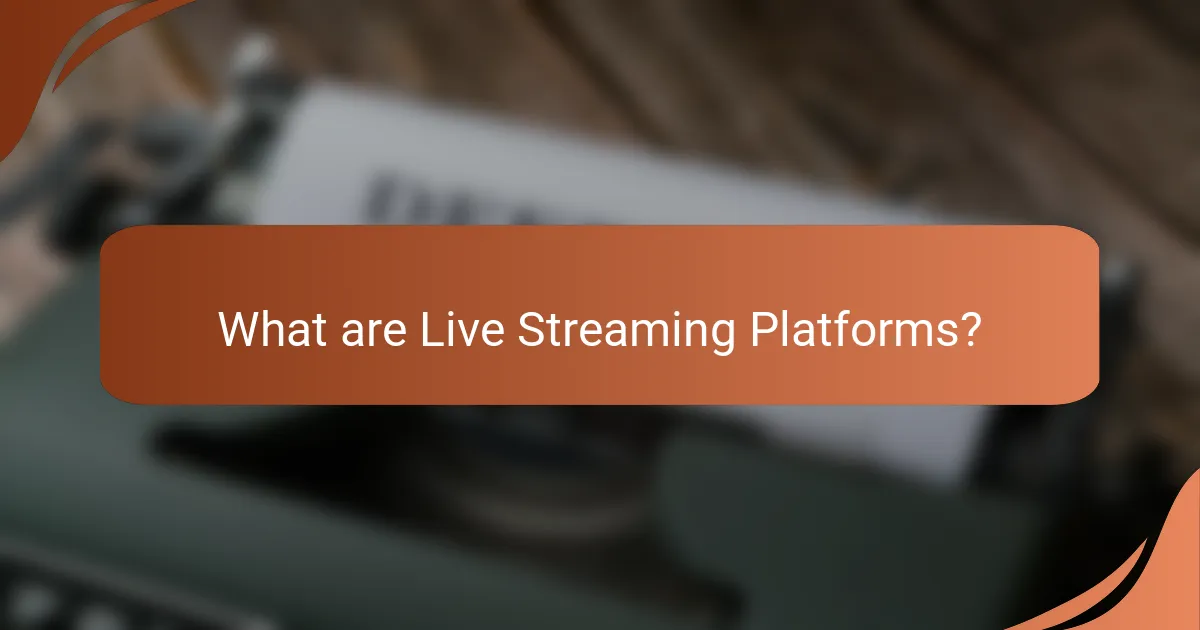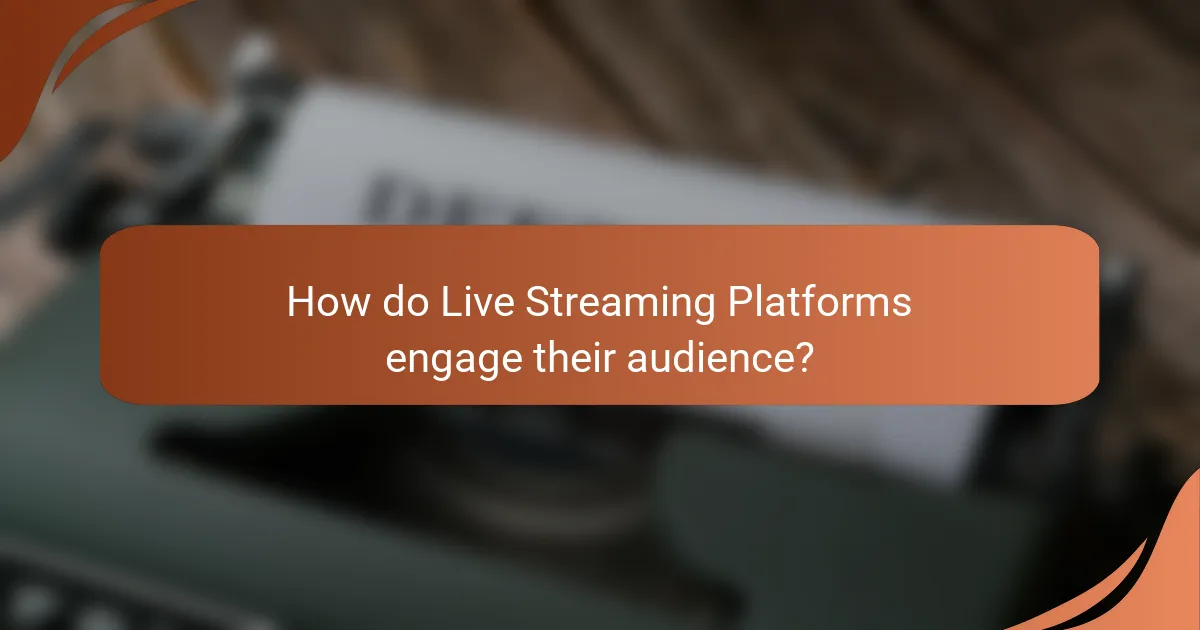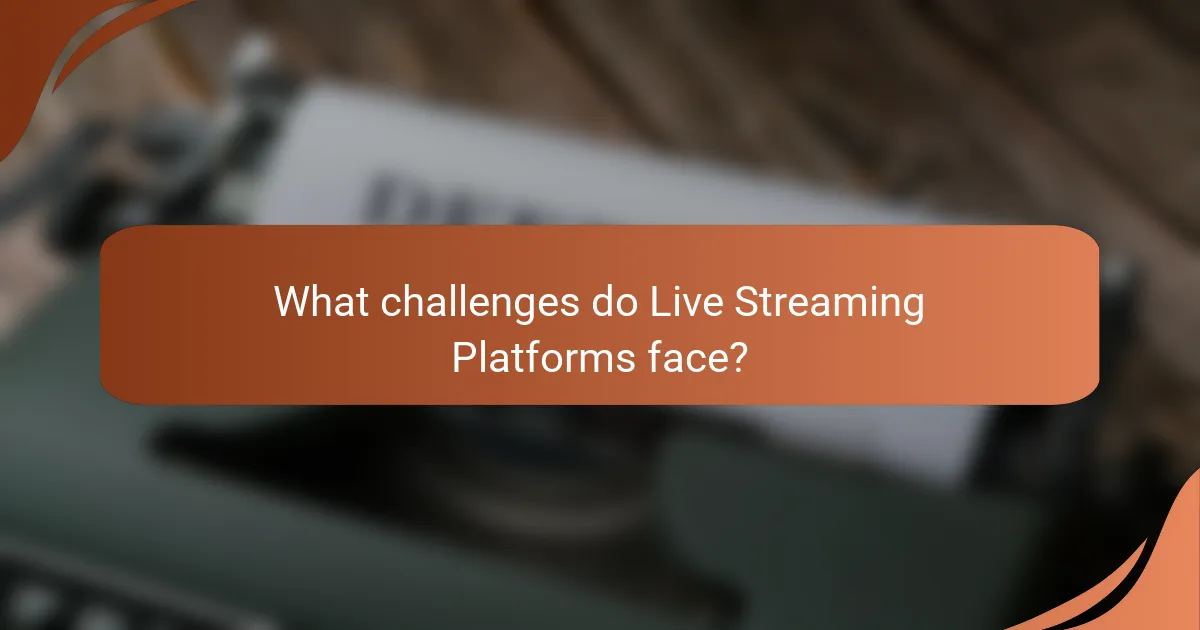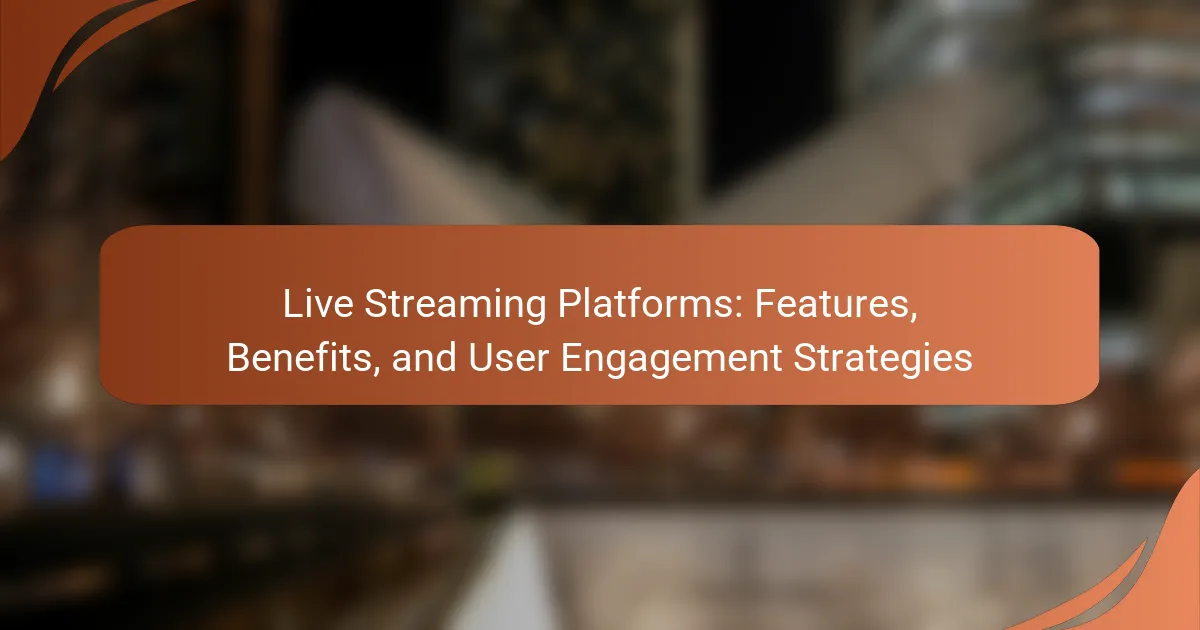Live streaming platforms are online services that enable real-time video broadcasting, allowing users to share events, gaming sessions, and personal broadcasts with an audience. Key features of these platforms include interactive tools such as live chat, polls, and gamification elements that enhance viewer engagement and foster community. The global live streaming market is projected to reach $247 billion by 2027, reflecting the increasing demand for real-time content. However, these platforms face challenges such as bandwidth limitations, content moderation, competition, monetization, and regulatory compliance, all of which can impact user engagement and platform success. This article explores the features, benefits, and user engagement strategies of live streaming platforms, providing insights into their operation and the factors influencing their growth.

What are Live Streaming Platforms?
Live streaming platforms are online services that enable real-time broadcasting of video content. These platforms allow users to stream events, gaming sessions, or personal broadcasts to an audience. Popular examples include Twitch, YouTube Live, and Facebook Live. They support interactive features such as live chat and viewer engagement tools. According to Statista, the global live streaming market is expected to reach $247 billion by 2027. This growth indicates a rising demand for real-time content consumption. Live streaming platforms cater to various audiences, including gamers, educators, and brands. They facilitate both user-generated content and professional broadcasts, making them versatile tools for communication.
How do Live Streaming Platforms function?
Live streaming platforms function by enabling real-time broadcasting of video content over the internet. They utilize various technologies to capture, encode, and transmit video feeds. Users can stream content from devices like cameras or smartphones. The platform then compresses the video for efficient delivery. It uses protocols like RTMP for streaming. Viewers access the content through web browsers or apps. Interaction features, such as chat and reactions, enhance user engagement. According to a report by Statista, live streaming accounted for over 15% of all video traffic in 2021.
What technologies are essential for Live Streaming Platforms?
Essential technologies for live streaming platforms include video encoding, content delivery networks (CDNs), and streaming protocols. Video encoding compresses video files for efficient transmission. CDNs distribute content across multiple servers, ensuring low latency and high availability. Streaming protocols like RTMP and HLS facilitate real-time video delivery. Additionally, adaptive bitrate streaming adjusts video quality based on user bandwidth. These technologies work together to enhance user experience and ensure reliable streaming.
How do different platforms handle streaming quality and latency?
Different platforms manage streaming quality and latency through various technologies and protocols. For instance, platforms like YouTube and Twitch utilize adaptive bitrate streaming. This technology adjusts the video quality based on the viewer’s internet speed. It ensures a smoother experience with minimal buffering.
In contrast, platforms such as Zoom prioritize low latency for real-time communication. They employ WebRTC technology to minimize delays during live interactions. This is crucial for maintaining the flow of conversation in virtual meetings.
Additionally, Facebook Live uses a combination of HLS (HTTP Live Streaming) and RTMP (Real-Time Messaging Protocol). This allows for a balance between quality and latency, optimizing the viewing experience for users on different devices.
Overall, the choice of technology directly impacts the user experience. High-quality streaming often comes at the cost of increased latency, while low-latency solutions may compromise on video quality.
What are the key features of Live Streaming Platforms?
Live streaming platforms offer several key features. These include real-time video broadcasting capabilities. Users can share content instantly with an audience. Interactive elements such as chat and reactions enhance viewer engagement. Many platforms support multi-device streaming for accessibility. Analytics tools provide insights into viewer behavior and engagement metrics. Monetization options allow creators to earn revenue through subscriptions or ads. Content moderation features ensure a safe environment for users. Additionally, integration with social media expands audience reach.
What types of content can be streamed on these platforms?
Live streaming platforms offer a variety of content types. Users can stream video games, which includes gameplay and tutorials. Live events, such as concerts and sports, are also popular. Educational content, including webinars and online classes, is frequently streamed. Additionally, talk shows and interviews attract audiences. Creative arts, such as painting or music sessions, are showcased as well. Fitness classes and wellness sessions provide interactive experiences. News broadcasts offer real-time updates on current events. These diverse content types cater to a wide audience, enhancing user engagement across platforms.
How do interactive features enhance user experience on Live Streaming Platforms?
Interactive features enhance user experience on live streaming platforms by fostering engagement and community participation. These features include live chats, polls, and reactions. They allow viewers to communicate directly with streamers and other audience members. This real-time interaction creates a sense of connection and belonging. According to a survey by StreamElements, 73% of viewers enjoy participating in live chats. Polls can also provide instant feedback, making content more relevant. Interactive features can lead to longer viewing times, as users feel more invested in the experience. Thus, they transform passive viewing into an active, participatory experience.
What benefits do Live Streaming Platforms provide to users?
Live streaming platforms provide users with real-time interaction and engagement. Users can connect with audiences instantly through chats and comments. This fosters a sense of community and belonging. Additionally, live streaming allows for immediate feedback from viewers. Users can showcase their talents or products to a global audience. This broad reach can enhance brand visibility. Furthermore, live streaming often includes monetization options for content creators. Statistics show that 80% of consumers prefer live video over traditional social posts. This preference highlights the effectiveness of live streaming in capturing audience attention.
How do Live Streaming Platforms facilitate real-time engagement?
Live streaming platforms facilitate real-time engagement through interactive features. These platforms allow viewers to comment, ask questions, and react during broadcasts. This instant feedback creates a sense of community among participants. Live chats enable direct communication between streamers and viewers. Features like polls and Q&A sessions enhance audience involvement. Notifications alert users to live events, ensuring timely participation. According to a report by Statista, 82% of viewers engage with live stream chats. This high level of interaction boosts viewer retention and satisfaction. Overall, these elements work together to create an engaging live experience.
What advantages do Live Streaming Platforms offer for content creators?
Live streaming platforms offer several advantages for content creators. They provide real-time interaction with audiences. This fosters a sense of community and engagement. Creators can receive instant feedback through comments and reactions. Additionally, live streaming allows for spontaneous content creation. This can lead to more authentic and relatable experiences for viewers. Monetization options are also available, including subscriptions and donations. According to Statista, the live streaming market is projected to reach $184.3 billion by 2027. This growth indicates a rising opportunity for creators to capitalize on their content.

How do Live Streaming Platforms engage their audience?
Live streaming platforms engage their audience through interactive features and real-time content. They utilize live chats to facilitate direct communication between streamers and viewers. This interaction fosters a sense of community and belonging among users. Many platforms also implement polls and Q&A sessions to enhance viewer participation. Gamification elements, such as rewards and badges, incentivize audience engagement. Additionally, personalized content recommendations keep users returning for more. Statistics show that platforms with high interactivity see increased viewer retention rates. For instance, Twitch reported that streams with active chat engagement retain viewers 25% longer than those without.
What user engagement strategies are most effective on Live Streaming Platforms?
Interactive features such as live chat and polls are the most effective user engagement strategies on live streaming platforms. These features allow real-time interaction between streamers and viewers. For instance, live chat enables viewers to ask questions and share comments instantly. Polls can gauge audience opinions and preferences during a stream.
Gamification elements, like rewards and badges, also enhance engagement. Viewers are motivated to participate actively when they can earn recognition. Additionally, incorporating Q&A sessions increases viewer involvement. Streamers who address audience questions build a stronger connection.
Regularly scheduled streams create anticipation among viewers. Consistency helps retain an audience over time. Collaborations with other streamers can expand reach and introduce new viewers. Engaging content that resonates with the target audience is crucial for sustained interest.
Data shows that streams with interactive elements see higher viewer retention rates. According to a study by StreamElements and Arsenal.gg, streams that utilize chat interactions have up to 30% more viewer engagement.
How does chat interaction influence viewer retention?
Chat interaction significantly enhances viewer retention on live streaming platforms. Engaging with viewers through chat creates a sense of community. This interaction encourages viewers to stay longer during broadcasts. Statistics show that streams with active chat have up to 30% higher retention rates. Viewers feel more connected to the content and the streamer. This connection fosters loyalty and repeat viewership. Additionally, real-time responses to comments keep the audience engaged. Overall, chat interaction is a critical factor in maintaining viewer interest and retention.
What role do social media integrations play in audience engagement?
Social media integrations significantly enhance audience engagement on live streaming platforms. They allow for real-time interaction between streamers and viewers. This interaction includes comments, shares, and reactions, fostering a sense of community. Additionally, social media integrations facilitate content sharing, increasing visibility and reach. According to a study by Statista, 54% of social media users engage with live video content. This statistic highlights the effectiveness of social media in capturing audience interest. Furthermore, integrated features like polls and Q&A sessions encourage active participation. Overall, social media integrations are crucial for boosting engagement and creating dynamic viewer experiences.
How can Live Streaming Platforms enhance viewer participation?
Live streaming platforms can enhance viewer participation through interactive features. These platforms often include live chat options. Viewers can communicate in real-time with hosts and other participants. Polls and surveys can be integrated during broadcasts. This allows viewers to express their opinions instantly. Gamification elements, such as rewards for participation, can also be utilized. These encourage viewers to engage more actively. Additionally, platforms can enable viewer-generated content. This allows audiences to contribute their own videos or comments. According to a study by Livestream and New York Magazine, 80% of audiences prefer live video over traditional social posts. This statistic underscores the effectiveness of live streaming in fostering engagement.
What are the best practices for encouraging audience interaction?
To encourage audience interaction, utilize real-time polls and Q&A sessions. These tools engage viewers and invite participation. Incorporating chat features allows for instant feedback and conversation. Encouraging comments and reactions during streams fosters a sense of community. Regularly acknowledging audience contributions enhances their involvement. Providing incentives, such as giveaways, can motivate interaction. Analyzing engagement metrics helps refine strategies for better results. According to a study by Streamlabs, interactive elements can boost viewer retention significantly.
How can polls and Q&A sessions improve engagement?
Polls and Q&A sessions can significantly improve engagement by encouraging active participation from the audience. These interactive elements create a two-way communication channel between the host and viewers. This engagement fosters a sense of community and connection. According to a study by Livestream and New York Magazine, 80% of users prefer live video over traditional social posts. Polls allow viewers to express their opinions in real-time, making them feel valued. Q&A sessions address specific questions, enhancing clarity and relevance. Together, these features can increase viewer retention and satisfaction during live streams.

What challenges do Live Streaming Platforms face?
Live streaming platforms face several significant challenges. One major challenge is bandwidth limitations. High-quality streaming requires substantial internet speed, which can lead to buffering if users have slow connections. Another challenge is content moderation. Live streaming often features user-generated content, which can include inappropriate material that needs to be monitored. Additionally, competition is fierce among platforms. Many options are available, making it difficult for any single platform to maintain a user base. Monetization is also a challenge. Platforms must balance ad revenue with user experience to avoid alienating viewers. Finally, regulatory compliance presents hurdles. Different regions have various laws governing content, which can complicate operations for global platforms. These challenges impact user engagement and overall platform success.
How do technical issues impact user experience on Live Streaming Platforms?
Technical issues negatively impact user experience on live streaming platforms. Buffering can interrupt viewing, leading to frustration. Low video quality can reduce engagement and satisfaction. Audio latency can cause confusion during live interactions. Connection drops can result in lost viewers and decreased audience retention. A report by Streamlabs indicates that 73% of users abandon streams due to technical difficulties. These issues can diminish brand reputation and user loyalty. Overall, technical problems create barriers to an optimal viewing experience.
What are common troubleshooting tips for streaming issues?
Common troubleshooting tips for streaming issues include checking your internet connection. Ensure that your bandwidth meets the streaming service’s requirements. Restart your router to refresh the connection. Close any unnecessary applications that may consume bandwidth. Clear the cache of your streaming app or browser. Update the streaming application to the latest version. Adjust the video quality settings to a lower resolution if buffering occurs. Finally, check for service outages from your streaming provider. These steps can resolve many common streaming problems effectively.
How can platforms ensure consistent performance during high traffic?
Platforms can ensure consistent performance during high traffic by implementing load balancing techniques. Load balancing distributes incoming network traffic across multiple servers. This prevents any single server from becoming overwhelmed. Additionally, platforms can utilize content delivery networks (CDNs). CDNs cache content closer to users, reducing latency and improving load times.
Scalability is also crucial. Platforms should be able to dynamically allocate resources based on demand. This means adding more servers during peak times and scaling down when traffic decreases. Furthermore, optimizing application performance is essential. This includes efficient coding practices and reducing the size of files being transmitted.
Monitoring tools play a vital role in maintaining performance. Real-time analytics can help identify bottlenecks and performance issues quickly. By addressing these issues proactively, platforms can maintain a smooth user experience. According to a study by Akamai, websites that load in two seconds or less have a significantly lower bounce rate. This highlights the importance of performance during high traffic.
What future trends are emerging in Live Streaming Platforms?
Emerging trends in live streaming platforms include enhanced interactivity, AI-driven content recommendations, and multi-platform integration. Enhanced interactivity allows viewers to engage in real-time through polls and Q&A sessions. AI-driven content recommendations personalize user experiences, increasing viewer retention. Multi-platform integration facilitates seamless content sharing across social media, expanding audience reach. According to a report by Statista, the global live streaming market is projected to grow to $247 billion by 2027, highlighting the increasing adoption of these platforms. Additionally, the rise of virtual events and hybrid experiences is reshaping how audiences connect. These trends indicate a shift towards more engaging and personalized live streaming experiences.
How will advancements in technology shape the future of live streaming?
Advancements in technology will significantly enhance the future of live streaming. Improved internet speeds will allow for higher quality video and audio. Technologies like 5G will reduce latency, providing real-time interaction. Enhanced encoding techniques will optimize bandwidth usage, making streaming more accessible. Artificial intelligence will personalize content recommendations for viewers. Advanced analytics will enable creators to understand audience behavior better. Virtual reality and augmented reality will create immersive streaming experiences. Blockchain technology may enhance security and monetization options for content creators.
What new features are anticipated to enhance user engagement?
New features anticipated to enhance user engagement on live streaming platforms include interactive polls, real-time chat enhancements, and personalized content recommendations. Interactive polls allow viewers to participate actively, increasing their investment in the stream. Real-time chat enhancements, such as emoji reactions and threaded conversations, foster community interaction. Personalized content recommendations leverage user data to suggest relevant streams, keeping viewers engaged longer. These features are designed to create a more immersive and interactive experience, which has been shown to boost viewer retention rates. For instance, studies indicate that streams with interactive elements can increase viewer engagement by up to 30%.
What are the best practices for using Live Streaming Platforms effectively?
The best practices for using live streaming platforms effectively include planning content in advance. This ensures a structured flow and keeps the audience engaged. High-quality audio and video equipment are essential for a professional presentation. Engaging with the audience through chat or Q&A sessions enhances interaction. Consistent streaming schedules help build a loyal viewer base. Promoting streams on social media increases visibility and attendance. Analyzing viewer feedback and metrics allows for continuous improvement. Lastly, incorporating calls to action can drive viewer participation and growth.
Live streaming platforms are online services that facilitate real-time broadcasting of video content, allowing users to engage with audiences through features like live chat and interactive polls. This article explores the functionalities of these platforms, the essential technologies that support them, and the various content types they host, ranging from gaming to educational webinars. It also examines user engagement strategies, including the impact of interactive features on viewer retention, and discusses the challenges faced by these platforms, such as bandwidth limitations and content moderation. Finally, emerging trends and best practices for optimizing live streaming experiences are highlighted, emphasizing the significant growth potential of the live streaming market.
